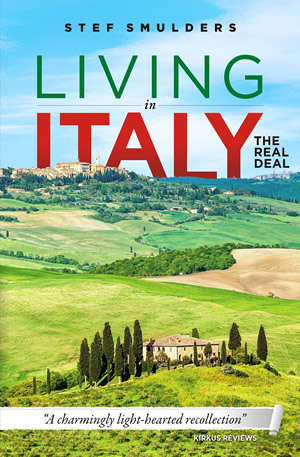
Far from the maddening crowd
If you stay in Milan for a somewhat longer period, you may want to leave the busy city for a day and visit some nice historical places nearby. This is definitely worthwhile as the whole of Lombardy has a lot of nature, art and history to offer.
What you can do on a daytrip depends on the mode of transport you have available. Some cities are conveniently reachable by public transport, for others you will need to rent a car.
Below we present a few possibilities, but there are more ☺!
Click on the image and name to open the panel for more info:
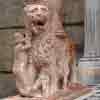 Bergamo
BergamoA city on two different levels
According to the inhabitants of Bergamo you either live in de 'Città', on top of the hill, or 100 meters lower in the 'Borgo', with its modern center of the town. This distiction however is not really between old and new, because already in Roman times both hill and the plain below were inhabitated.
Although the lower city has its own interesting streets, churches and monuments, if you go for a short visit to Bergamo the Città is the most obvious choice. A nice start of you visit is to take the steep ride in the funicular that will transport you up to the old town. (from Viale Vittorio Emmanuele).
Place of interest in the old town are:
- Via Gombito, a narrow street with lots of shops, but you can still see here details of some of the old medieval houses.
- Piazza Vecchia, this renaissance square represents the core of Città Alta: it has been the heart of political power for centuries
- Palazzo Nuovo. This building was designed in 1593 but it was only finally finished in 1928!
- Piazza del Duomo e il Duomo
- Santa Maria Maggiore church
- Battisterio
- Viale della Mura,
How to get there:
By car. Motorway A4 to Venezia
Train:There are regular trains from Station Porta Garibaldi to Bergamo
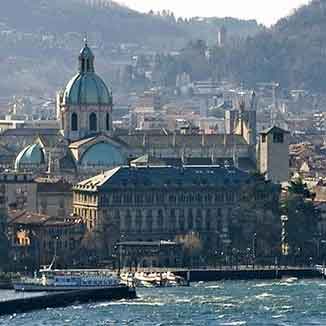 Como
Como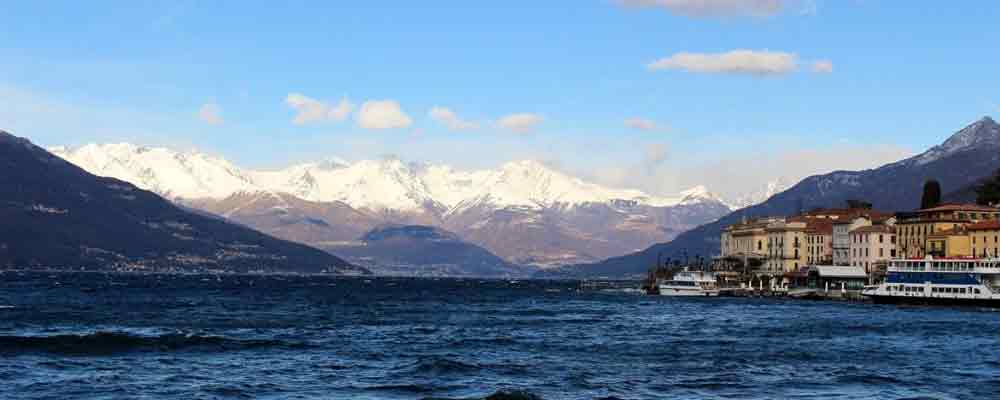
The city by the Lake
Como maybe mainly known abroad with the word Lake added to it, The city of this name is nevertheless the main point of departure for trips on or around the lake.
The city of Como also has its own history and interesting sights that make a separate visit worthwhile. Como is located only 40 kilometers from Milan.
Main sights:
- Duomo (look for the statues of citizens Pliny the Elder & the Younger next to the portal, tapestries inside, works of Luini & Ferrari)
- Basilica of Sant'Abbondio (14th century frescoes)
- San Fedele
- Villa Olmo with its pleasant park
- Tempio Voltiano (dedicated to Alessandro Volta)
- Broletto (the city’s medieval town hall)
- Casa del Fascio (prime example of 20th century Italian architecture)
- There is also a museum dedicated to the silk industry, which has always been prominent in Como.
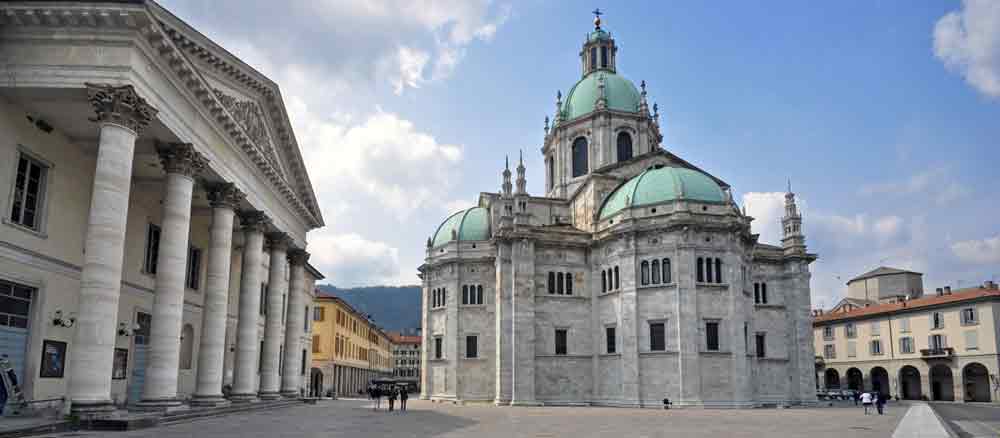
From the north-eastern part, close to the lake, you can take a ride up with the funicolare train to Brunate for a magnificent view of the city and the lake (leaves every 30 min from 6-10:30).
How to get there
With the MilanoCard you can book a daytrip from Milan to Como and the Lake, which includes a visit to the city.
 Cremona
Cremona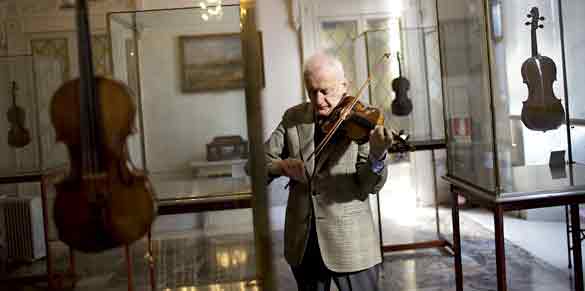
City of Stradivarius, Violins and Nougat
The city of Cremona lies at only a 1 hour drive from Milan and definitely is worth a day trip if you are interested in historical locations and ... violins.
Cremona happens to be the birth place of Stradivarius, the Guarnieri's and Amati and still is a major violin producing community. You can visit a museum dedicated to the violin and have a look at the city's violin collection.
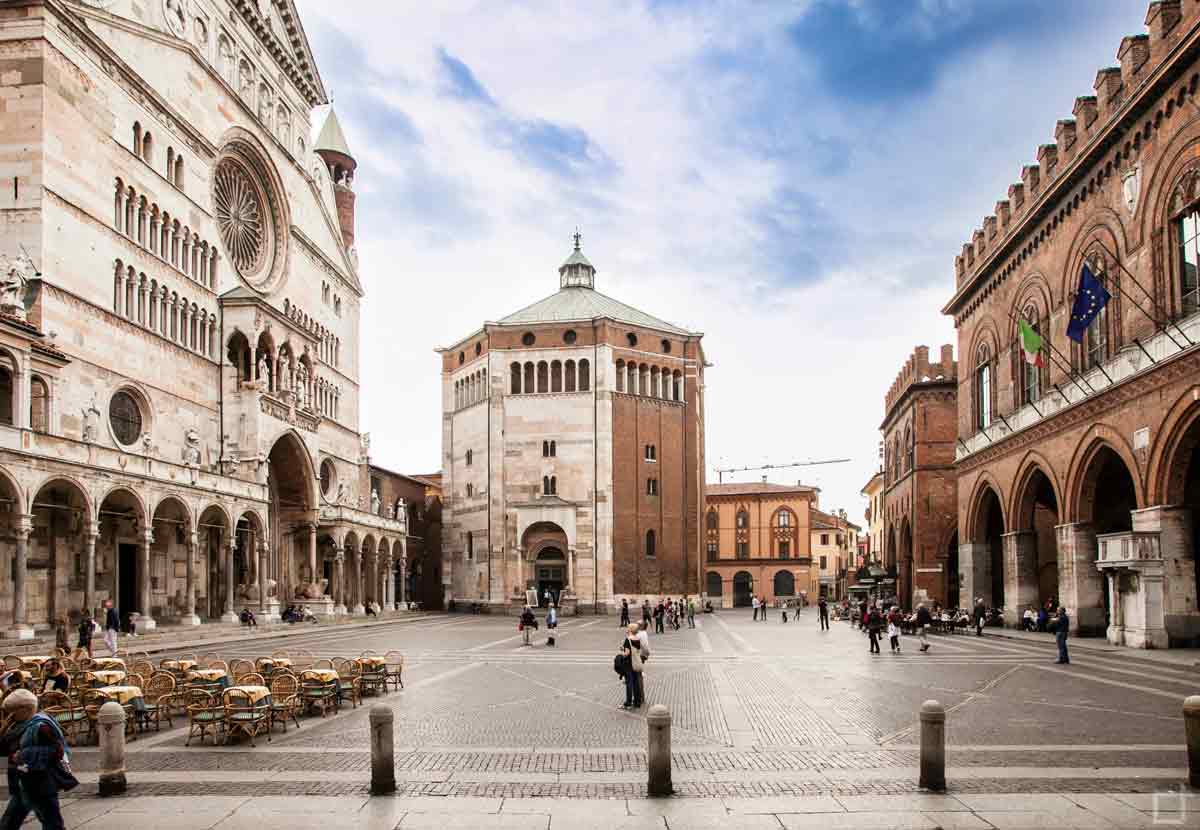
Piazza Duomo
Apart from that, Cremona also has one of the most beautiful medieval squares of Italy, with the Duomo, Palazzo del Comune, Torrazzo, the Battistero and the Loggia dei Militi.
The nice thing about Cremona is that you can easily see the whole of the city on foot, with the only exception of the San Sigismondo abbey.
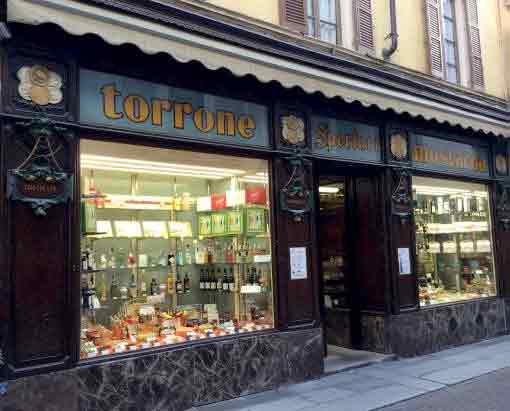
The Sperlari shop
For the sweet tooths it may be nice to know that Cremona is also the home of the torrone, a kind of nougat, which you may buy at Sperlari's.
How to get there:
The fastest route for Cremona is via the motorway A1 to Piacenza and then for Cremona. The touristic route runs via Lodi and takes half an hour extra.
Cremona can be reached by train, in case you don't have a car. On the Trenitalia website you can plan you itinerary.Trains to Cremona are not very frequent (plan ahead!) and the trip takes over an hour, at a cost of 6-7 euro.
 Lodi
Lodi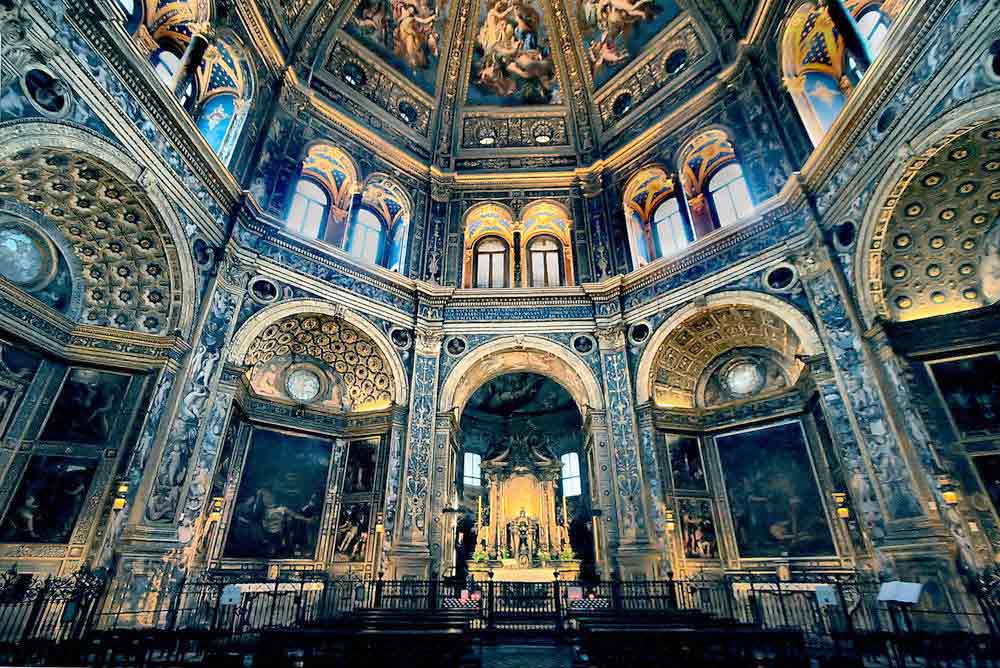
The Civic Temple of the Blessed Virgin
The main reason to visit Lodi, apart from the pleasant square and Duomo, is the beautiful temple dedicated to the blessed uncrowned Mary.
It's called civic as this prime example of Renaissance Lombard architecture has always been property of the citizens and the comune and not of the diocese.
Its origins date from the miraculous tears that a 13th century fresco depicting Mary began to shed in the 15th century, reason for the citizens of Lodi to erect the current sanctuary.
The interior is a real art gallery of 15th till 19th century frescoes and paintings.
Look for:
- Piazza's Story of Abraham (at the entrance)
- the Epiphany above the big entrance door
- the beautiful women's gallery (blue and gilded columns)
- the works of Bergognone (Annunciation, Presentation of the Temple),
- the Piazza polyptich,
- the wooden choir
- the 16th century organ
- the cupola
A presentation of liturgical objects from the history of the Temple can be found in the museum, under the temple itself (free, open only Sunday afternoon).
In the Duomo on the main square look for the major entrance door with the sculptures of Adam and Eve, the many works of the Piazza family in the chapels and especially the Diocesan Museum with the treasure of St Bassian.
A bit further out of the city lies what once was the ancient Lodi, Lodi Vecchio or Laus Pompeia, before the Milanese destroyed it completely in 1158. Now you can admire the 14th century Basilica of St Bassian (Via Ada Negri, open daily 3-5, phone 0371 752900), with frescoes of the Master of St Bassian of agricultural life and crafts.
How to get there:
Lodi can be reached by train within half an hour from the Stazione Centrale with trains at a hourly frequency for about 4-7 euro's.
By car you may choose the A1 toll motorway (6 euro's) to go off at Lodi exit at about 40 km from Milan center. Or take the sightseeing route along the Via Emilia Ss 9.
 Monza
Monza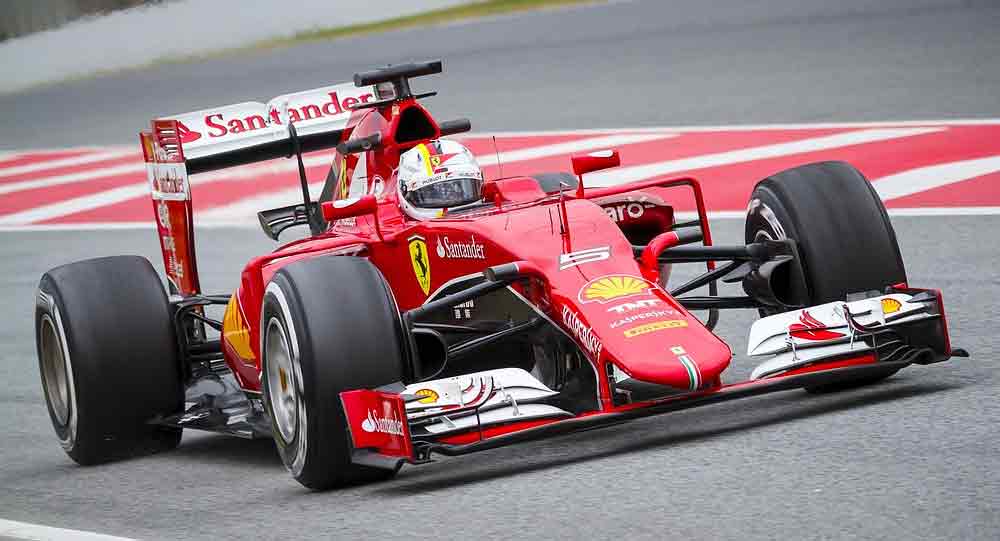
Entering Lombard territory
Monza is mainly known abroad for its Formula 1 racing track, but hosts a few other artistic and historical gems as well, apart from being a pleasant city to visit on its own.
There is the historical city and there is the park of which the Autodrome is part. Both are equally large, with Monza lying at the base of the park.
In Monza you need to visit the Gothic Duomo or Basilica of San Giovanni Battista, that was originally commisioned in the 7th century by the Lombard Queen of Italy, Teodolinda, but rebuilt in the 14th.
The major attraction in the church still is connected to the queen though, the Teodolina treasury, which counts as one of the most important treasuries in artistic-historical value in the world. It has now been organised as a museum (Tues-Sun, 8€, you have to make reservation in advance, tel.:039.326383) with 9 rooms.
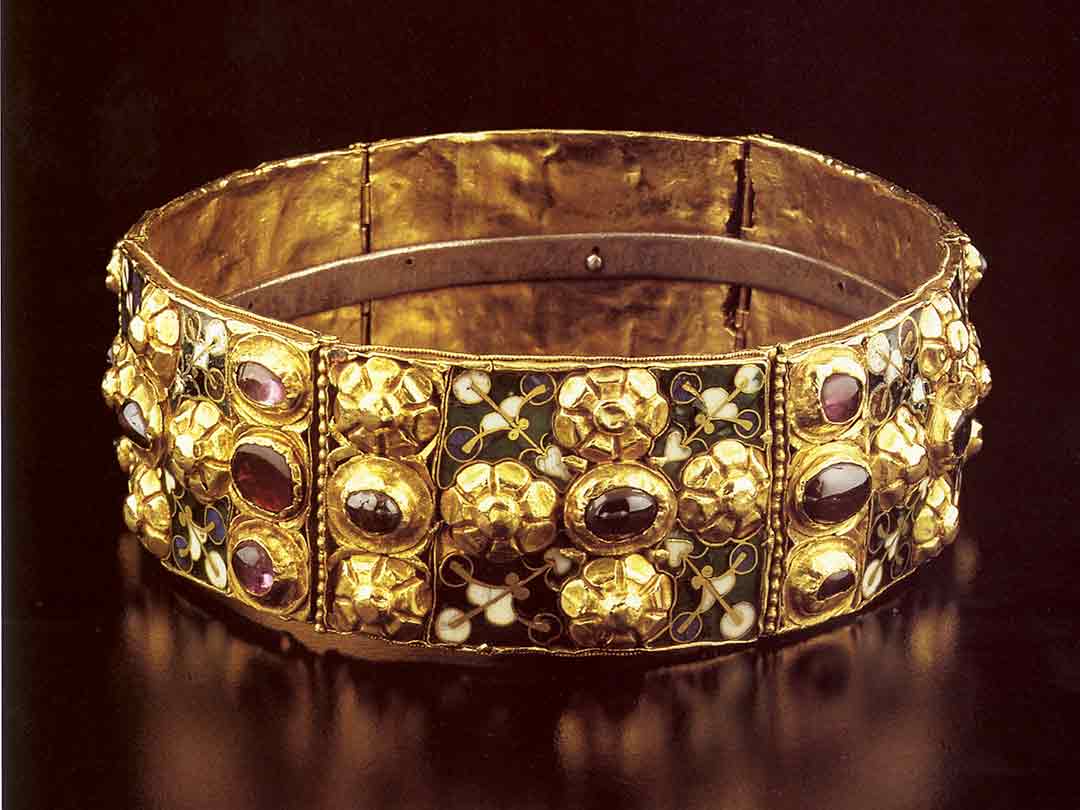
The golden votive crown of queen Teodolinda
The major objects of art (among many others) are the golden votive crown of the queen, an ivory diptich of 500 and a marvelous piece of Longobard smithswork, a golden hen and seven chickens, representing Lombardy and her seven provinces. In the church itself look for the evangelicatorio or choir by Campione and Teodolinda's chapel with the Iron Crown of Lombardy. Definitely worth the trip!
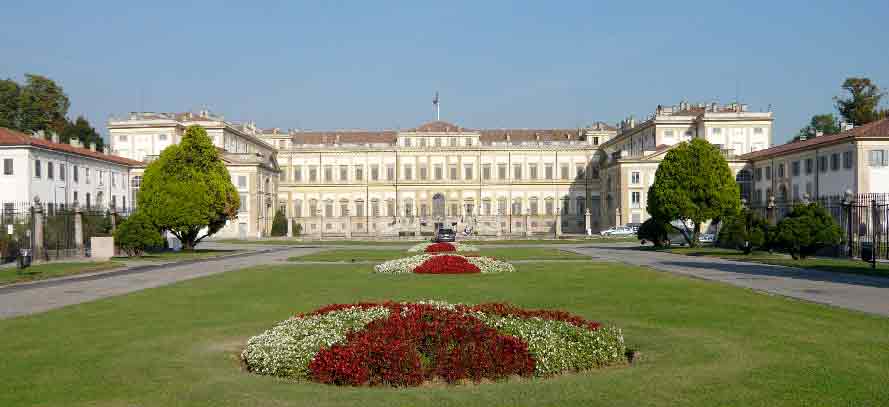
After visiting the Duomo, head for the park to relax and admire the Villa Reale and its gardens. This 18th century palace complex is being restored but still open for the public.You may visit the Royal Chapel, the Rotonda orangerie, the Royal apartments and the Royal Theatre.
Finally then there is the park with the Autodrome racing circuit, that is open for public at a fee of 5€ on days without events, from 8-6:30 (lunch break 1-2:30). A calendar of events is available at the Autodrome website. The F1 race usually takes place in september.
How to get there:
The easiest way to get to Monza from Milan by public transport is to take the regional train from
Porta Garibaldi railway station (15 minutes).
 Oltrepò Pavese
Oltrepò Pavese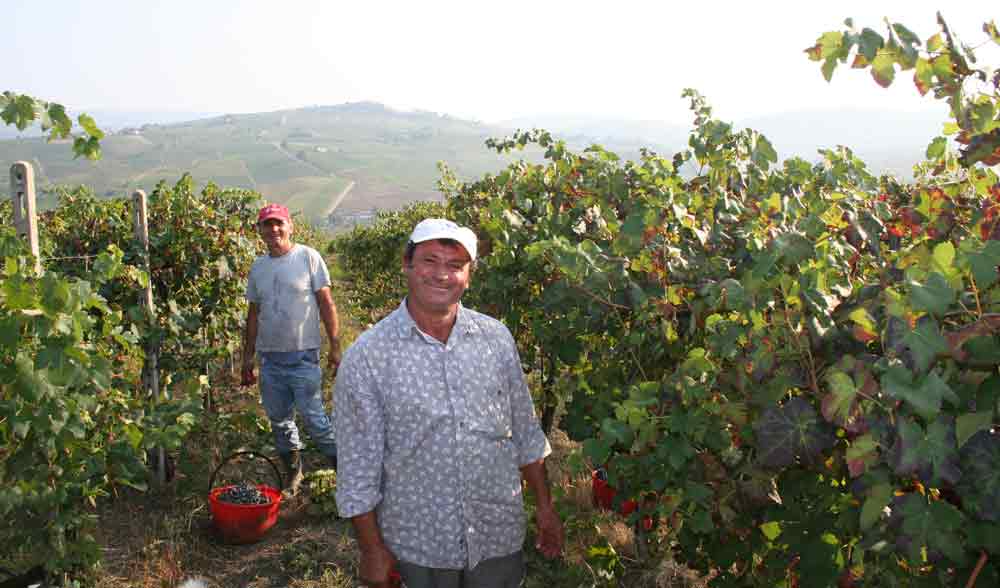
The undiscovered "Tuscany" of Lombardy
About 65 km south of Milan and only 30 km of Pavia at the foothills of the Apennines the Oltrepò Pavese stretches out her vineyards, woods and meadows. A landscape reminiscent of Tuscany, with smooth hills, medieval castles, ancient villages and panoramic views.
Though being the largest wine producing region of Lombardy and one of the largest of the whole of Italy, the name Oltrepò Pavese hardly rings a bell with anyone. It is still undiscovered territory, tranquil and traditional, as if time has forgotten to touch this area.
The Oltrepò Pavese may easily (and should) be visited on a daytrip from Milan, for example on a Sunday, when restaurants in the big city are closed, whereas in the countryside the traditional Sunday lunch, il pranzo della domenica, is served. An experience not to be missed! If you manage to find the place, the lunches at Azienda Agrituristica Bagarellum in Montecalvo Versiggia and Agriturismo Selvatico in Rivanazzano are top of the bill.
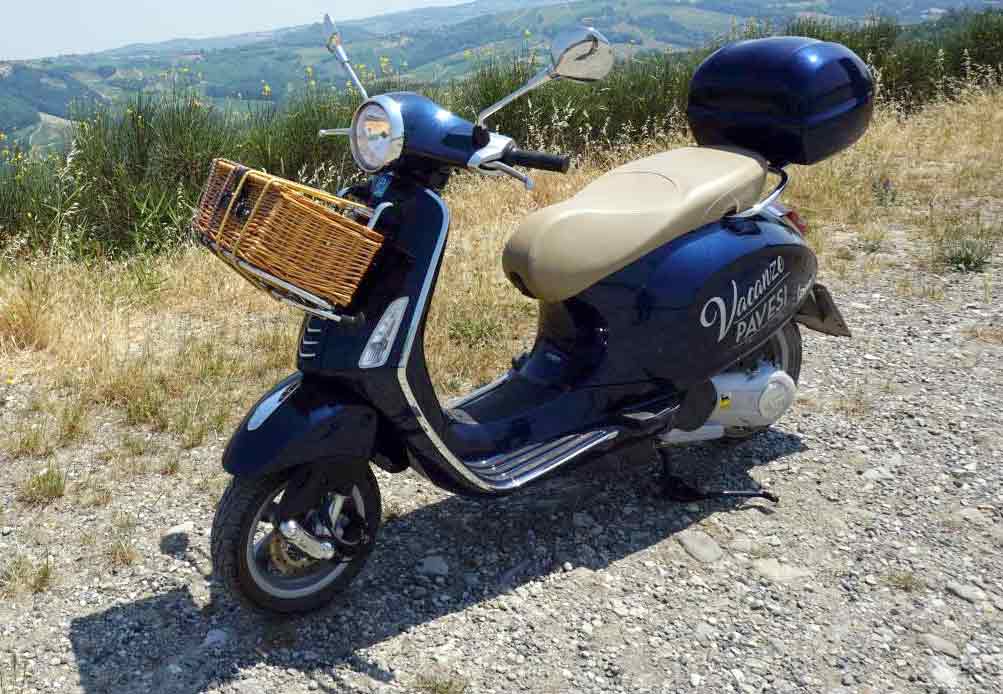
The best way to discover the area is to tour around with you own car, or as an attractive alternative on your own Vespa: you will set out on a route through enchanting scenery, taste local products, see castles, and hear the legends that surrounds them. See for more info on the Vespa tours the website of Vacanze Pavese.
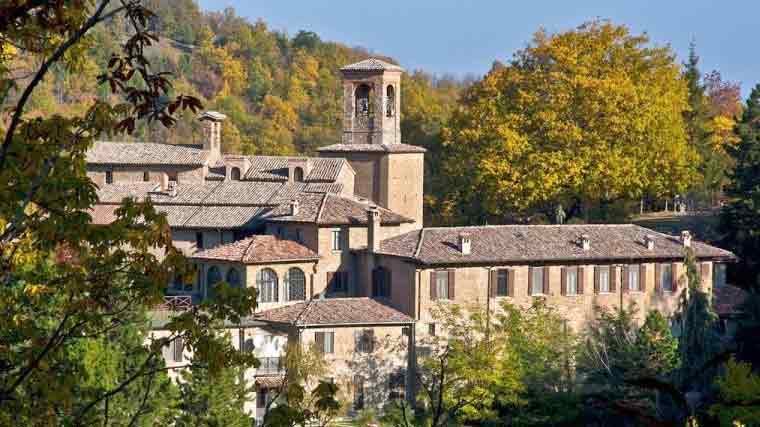
Abbey of San Alberto di Butrio
Interesting places to visit are:
- the monastery of San Alberto di Butrio
- the medieval city of Varzi
- Zavatarello and it's castle
- the Penice pass
- the botanical garden in the beautiful Romagnese area
- the Monte Alpe nature reserve.
You' ll be surprised by how quiet it is and by the spectacular panoramic views along the way, such as from Cigognola with its castle.
There are over 100 independent wine producers in the area and some are located in historic buildings, fine examples of these "Cantine storiche" are: Montelio Travaglino, il Montù,
You'll definitely want to come back another time and stay in this secret paradise, e.g. at Bed & Breakfast Villa I Due Padroni.
How to get there
(60 km, 1 hr)
There are several ways to reach the region from Milan.
The main access is by the state road no. 461 of the Penice Pass, winding up the valley from Voghera. The nearest motorway accesses are Casei Gerola (36 km away) or Casteggio (40 km away) on the A7 Milan-Genoa motorway and Voghera (32 km away) on the A21 Turin-Brescia motorway.
You may also take the road to Pavia, and then the ring road (Tangenziale) east, direction Oltrepò, Stradella and Broni. In this case you will pass the 1 km century old Ponte della Becca at the confluence of the Po and the Ticino.
Yet another way is to take the motorway to Piacenza and then the A21 direction Turin, to exit at Broni-Stradella.
 Pavia
Pavia

The ideal city to stroll and relax
Pavia, at a short distance south of Milan, happens to be one of the nicest cities in the region for a nice stroll. All of Pavia can be visited on foot and along the way there are lots of quiet little squares with benches in the shadow of trees.
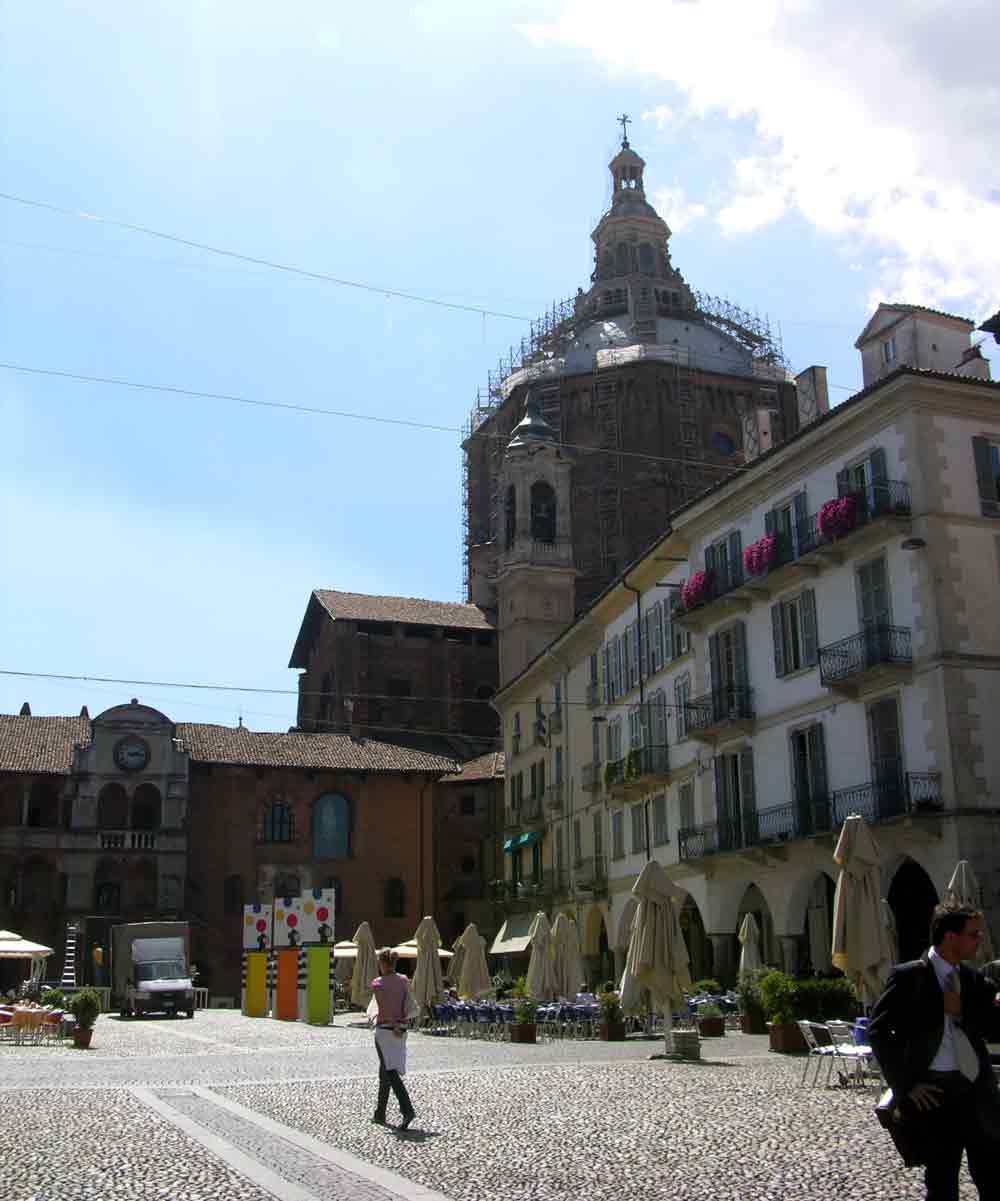
Piazza Vittoria
Pavia is quiet during the lunch hour(s), but becomes lively at aperitivo time: go to the Strada Nuova and
Piazza Vittoria to see the citizens meet, chat and show off, or try the Lounge Bar Minerva.
The city (capital of Lombard Italy once, and the place where Frederic Barbarossa was crowned king) is a hidden gem in it's own, as the Pavese are not very active in promoting their treasures, such as the San Pietro in Ciel d'Oro, San Michele and in particular the Certosa di

Certosa di Pavia Abbey
Pavia abbey, a few km north of the city, which is definite must see for any visitor of Milan.
Other sight not to miss are the Castello Visconteo (housing several museums and surrounded by a small park), the University complex (a maze of historical courtyards, several museums as well), the Piazza Leonardo da Vinci with the three civic towers (Pavia used to have hundred) and the Ponte Coperto at the Ticino river.
How to get there
(40 km, 50 minutes)
The fastest way from Milan is to take the A7 to Genoa and then go off at Bereguardo, which will cost you about 2 euro of toll. Another possibility is to take the provincial SS35 road to Pavia, which also passes the Certosa, which you may then visit along the way.
There is a reasonably frequent train service as well, the trip taking only half an hour at a cost of about 4-8 €.
 Vigevano
Vigevano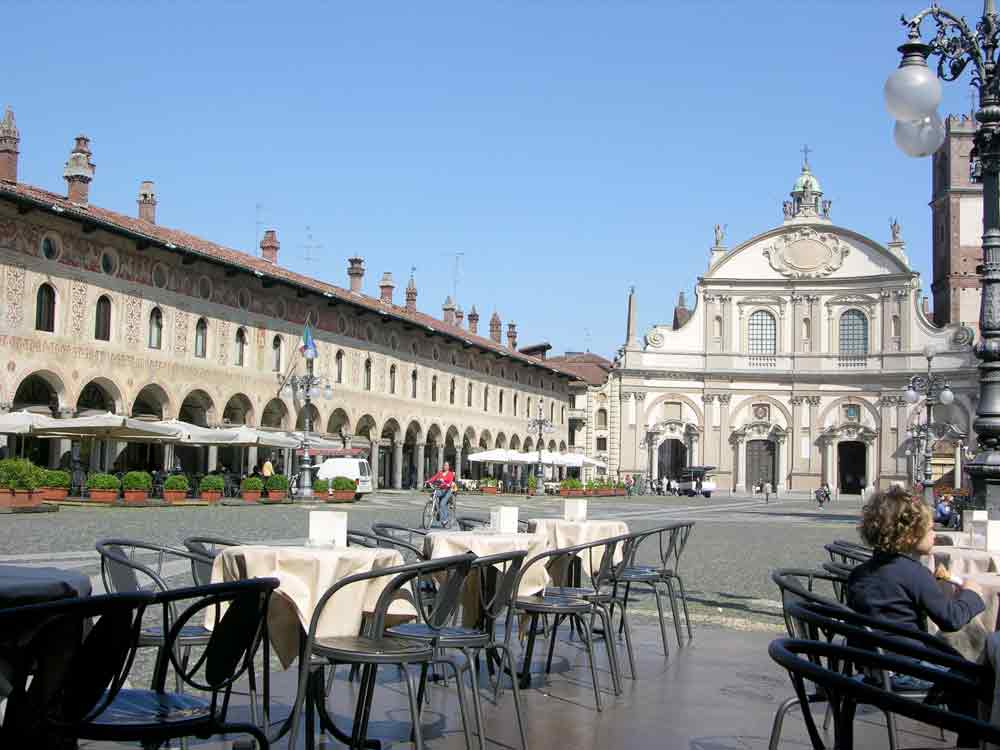
Birthplace of Ludovico il Moro Vigevano
Vigevano's era of fame lasted for about two centuries, when during the Renaissance period the city was governed by the Visconti and Sforza families respectively.
The main sights of Vigevano logically also date back to the golden era, the magnificent Piazza Ducale and the Castello Sforzesco. Also worth visiting however is the baroque Duomo, that also faces the central square.
On the way to or from Vigevano you may want to stop by the Abbey of Morimondo.
How to get there
By train from Milan at a 30 min to hourly service, duration 25 min, cost 3 euro's.
By car about 50 minutes along the Naviglio Grande, Strada Vigevanese S494 to Abbiategrasso and then south.
 Home
Home Practical info
Practical info Sights not to miss
Sights not to miss Bars & Aperitivo
Bars & Aperitivo Churches & Abbeys
Churches & Abbeys Day trips
Day trips Family Fun
Family Fun Fashion & Shopping
Fashion & Shopping Markets
Markets-
 Museums
Museums  Park & Gardens
Park & Gardens Restaurants
Restaurants
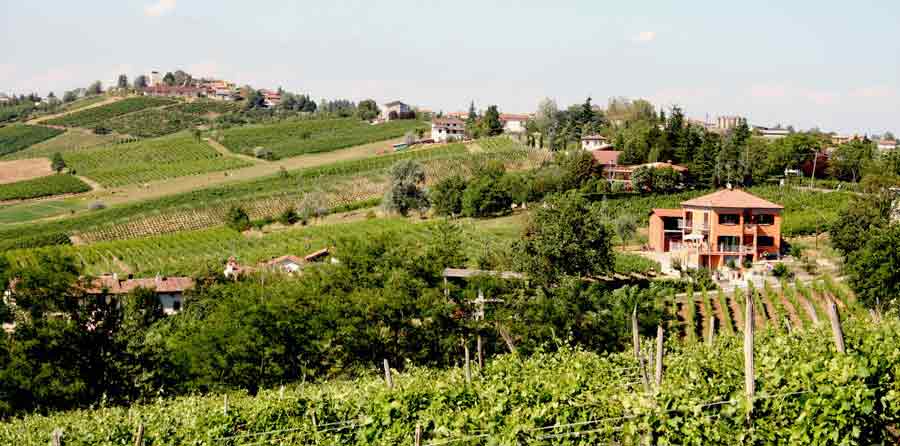
New
Living in Italy: the Real Deal
Ever thought of moving to Italy and enjoying the 'Good Life'? Read this book about two Dutchmen who have moved to Italy together with their dog, and the story of their new Bed & Breakfast.
The hilarious & horrendous adventures of two Dutch expats and their dog in Italy
About mafiose real estate agents, Mussolini-type builders, lousy plumbers, Italian neighbours, murderous veterinarians, horrors in hospitals, tasting wine, eating pizza, visiting the theatre, truffle hunting and much more!
Winner Reader Views Literary Fiction Award & 2017 Eric Hoffer Award Finalist
Buy at Amazon (paperback/ebook) and other retailers
v>
